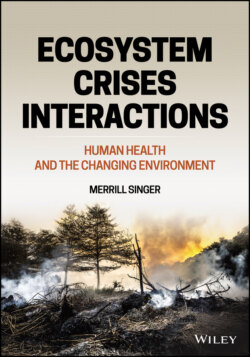Читать книгу Ecosystem Crises Interactions - Merrill Singer - Страница 2
Table of Contents
Оглавление1 Cover
2 Title Page
3 Copyright Page
4 Dedication Page
5 Preface
6 1 Introduction: public health, EcoHealth, planetary health, and you 1.1 Connections 1.2 Is this a dangerous book? 1.3 Three alternative approaches to health and the environment 1.4 Global warming or climate change? 1.5 Depth of the human footprint 1.6 Introducing ecocrises interactions and health 1.7 Thresholds in the environment 1.8 Sustainability of human life on Earth 1.9 How did things get this bad? 1.10 Age of the Anthropocene 1.11 The hottest year on record 1.12 Organization of this book References
7 Part 1: Impact on ecosystems 2 Intricacies of ecosystems 2.1 The nature of nature and the pathway to understanding 2.2 Developing a historic understanding of ecology and ecosystems 2.3 Modern ecology References 3 The social and technological making of environmental crises 3.1 Earth is now a different place 3.2 The longue durée and the rise and development of capitalism 3.3 Environmental neoliberalism and the polluting elites 3.4 The Anthropocene or the Capitolocene? 3.5 The future of Eaarth References 4 Engaging catastrophe 4.1 Introduction to a dismal theme 4.2 Prepping for doomsday 4.3 The record of past radical environmental change 4.4 Popular concern with the environment References 5 A home in peril: major contemporary environmental crises 5.1 Case studies in contemporary environmental crises 5.2 Deforestation 5.3 Acidification of the oceans 5.4 Eutrophication of estuarine and coastal waters 5.5 Depletion of the oceans 5.6 Pollution of waters 5.7 Oil spills 5.8 Desertification 5.9 Concluding remarks References 6 The threat of ecocrises interaction 6.1 Compounded perturbations and ecological surprises 6.2 Climate change and polluted Superfund sites 6.3 Global toxic sites and climate change 6.4 The ecocrises of unfettered mining 6.5 Cement, asbestos, and climate change 6.6 The climate change–nuclear ecocrisis nexus 6.7 Concluding remarks References
8 Part 2: Environmental crisis 7 Encountering degrading environments 7.1 Complexities of the environment–health nexus 7.2 Ecosystem distress syndrome 7.3 Case studies of degraded environments 7.4 Case studies of fragmented environments 7.5 The dilemma of simplified environments 7.6 Fragmented environments, ticks, and human health 7.7 Solastalgia: distress linked to environmental change References 8 Climate change, crisis enhancement 8.1 Consensus on climate change 8.2 Driving climate change 8.3 How serious is climate change? 8.4 Drought and heatwaves 8.5 Melting land ice and tundra 8.6 Coastal flooding 8.7 The polar vortex 8.8 Hurricanes, cyclones, typhoons, and tropical storms 8.9 Infectious diseases 8.10 Food loss to heat and insect pests References 9 Business as deadly usual: resisting environmental science 9.1 A consistent pattern of climate change denial 9.2 A time of questioning environmental science 9.3 Skirting accountability: polluters, innocence, and the victim slot 9.4 Fighting for the “right” to pollute 9.5 Deadly business: Big Energy and the denial of climate change 9.6 The politics of climate change denial 9.7 The institutions of the climate change denial machine 9.8 Taking climate change deniers to court 9.9 Fundamentalist denial References
9 Part 3: Human health risks with changing environment 10 Crossing boundaries and thresholds 10.1 Are there biophysical boundaries for humanity? 10.2 Key biogeochemical and biophysical Earth system processes 10.3 Exploring planetary boundaries 10.4 Environmental tipping points References 11 Time for change? Toward sustainability, toward life 11.1 Why go to school? 11.2 Social movements 11.3 Stepping toward change 11.4 Toward changing the system: addressing ultimate causes 11.5 The solidarity economy 11.6 Stateless democracy 11.7 Ecosocialism References
10 Index
11 End User License Agreement
